
|

|
LINKS FOR THE YEAR 2002 |
| [JAN] [FEB] [MARCH] [APRIL] [MAY] [JUNE] [JULY] [AUG] [SEPT] [OCT] [NOV] [DEC] |
Archives [Intro] [2000] [2001] [2003] |
|
Log for the week of May 5, 2002 Coff's Harbour NSW by APW An entire week of rain. We got a taste of what our friends in New Zealand have been going through. Luckily, we got most of the boat painted before the deluge arrived. There is just a four-foot square area in the cockpit where we ran out of paint. I was a little nervous about showing my face at the paint store so soon after last week's paint can explosion, hopefully the rain will erase any unpleasant memories. With the bad weather, we have gotten a lot of projects finished and didn't feel guilty about doing them, even the ones not important to the boat. Phil decided at long last to finally finish the nav station. This had been in an unfinished state, until we could decide what would really work best while at sea. I had been working on some dollhouses for the Willy Bolton girls, digitized all of our slides, got worldvoyagers.com version 2.0 in the can, and I've been wracking my brain over my most challenging case to date. My own cat, the kitty king. I am, of course, convinced Stewart has the big "C". The really big one. I just hope I am wrong. Other than reverting back to "cat" status he had not been eating his dry food had been picking at his wet food while living entirely at floor level. He also seemed "spaced out". Sort of like Phil and me. I had found weird lesions in his retina and around his optic nerve and started him on Clindamycin at a very high dose- hoping to treat a resurgence of toxoplasmosis, which he had back in Maine. I had also been guilty of feeding him raw meat packaged as "Aussie Finicky Cat cat food"- perhaps he had picked something up from that. I was hopeful. I made an official appointment for Stewart to see Garth, and got to see things from the "patient point of view", for once. An interesting experience in and of itself. While seated in the waiting room, a young teenaged girl came in to pick up some medicine for her young terriers that were suffering from Demodex. Demodex is a mite found on the skin on just about everyone. It likes to live deep in hair follicles, and is not the mite that causes "mange" that everyone associates with the itchy scratchy mangey dog. Dogs with demodex problems, usually have an immune system which is out of whack. Usually they are adolescent dogs whose immune system is changing. The mite can set off a very bad bacterial infection in some dogs. The young girl was very pretty, as most of the girls in Australia are, with blonde hair, fair skin and blue eyes. She, however, was suffering from a very bad case of teenage acne. She was listening very intently to Garth's associate explain changing immune systems, adolescence and skin infection. Nodding at the end and pointing to her own face as a case in point. It hit me like a cold wave in the Tasman sea. Could Demodex be triggering teenage acne? Do dermatologists check for that in their teenage patients? I had to resist the urge of jumping up from my seat and attempting to look for demodex on this poor girl. Oh yuck! So what does any of this have to do with yachting and sailing around the world? Not much, other than I get frustrated hearing from young people that they are bored and don't know what to do with their lives. There is so much in this world to learn, to discover, to see, feel and taste. Search for answers, ask lots of questions. Don't spend your time foolishly!!! I will never forget the sound of a kookaburra outside our tent, the smell of frangipani far out at sea, miles to leeward of an island in the Tuomotos, the taste of Fijian curry, swimming with sea lions and penguins in the Galapagos, the sight of the most beautiful women in the world on a beach at Macdonald's in Tahiti. I no longer have regrets about making this trip, each day has taken me further from my provincial Bostonian attitudes. I will not be the same person when I arrive back in Maine. Even the very worst times, or the very worst curry, when viewed through the retrospectoscope has been something of an adventure. But I digress, it is all too easy to drift to far off sweet places when the present has such an unpleasant taste. When I let the cat out of the bag, so to speak, Stewart, proceeded to meander around the exam room and then straight into the wall, much like a battery operated Christmas toy. I felt suddenly like so many of my clients, who don't really know the extent of their pet's blindness until they decide to change the furniture around. Stewart had more than a 'Have you seen my reading glasses?' kind of problem. I instantly thought the worst- brain tumor. Garth got some x-rays and repeated the blood work. His arthritis, on x-ray, is not much worse and certainly no better, than a few months ago. Garth, like me, feels it is not degenerative- but probably auto-immune. Stewart has led such a coddled existence that it is unlikely his arthritis is from trauma, as it would be with degenerative disease. More likely a kitty rheumatoid arthritis. Auto immune diseases to me, have always been a limited diagnosis- not a definitive diagnosis, because I don't think autoimmune disease is the primary problem. I think it is the result of something else. The question is though- the result of what? Why would your immune system go haywire and start attacking perfectly good body parts unless it had been "turned on" to do so, by something else. Researchers speculate it could be a drug, a chemical, a vaccination, or an infectious agent. I put my money on the latter as I think life is a constant battle between "us and them". The 'them' being the bacteria in our gut, on our skin, virus's sneezed on us, coughed on us, guzzled in with a cool glass of water, prions in the undercooked mutton and perhaps other agents we think are benign and are really wolves in sheep's clothing. So what do we do? If we were back in Maine, the choice would be easy- as we just happen to have the best veterinary neurologist in the world. CT scans and brain surgeries are his specialty. (Brain tumors don't usually show up on x-rays). I got "the" lecture from Garth, the very same one I got from my mother before she flew back to the states. The letting go, sometimes it's for the best one...
The next day Stew was perambulating around with his outboard motor in full gear. Phil and I both asked him- "Stew would you like to be murdered?" Not really a fair question, I know, as a vet especially, but he doesn't know the meaning of "Put to sleep." He vigorously shook his head "No!" But how far do we go? How many tests do we put him through? Money where he is concerned, is irrelevant. I would rather spend the rest of my life with a five thousand dollar car, than a twenty thousand dollar car- if I knew that was the difference in getting him home. But is it fair to him? Am I just being selfish?
On one of the visits I made to my grandmother when she was dying, she, with great difficulty, said we treated our pets better than our people. She very much wanted to die and had at that point, gone five days without eating. She wished that I could put her to sleep. I felt sick with grief and completely helpless. So, with that in mind I have always used the three day model for my clients with very old terminal animals, where nothing more can be done. If they haven't eaten for three days an alarm goes off, by day four they should be more than just thinking about euthanasia, and by day five there should be no question. Stewart is now back to eating with gusto.
Joseph, a very famous Australian marine artist, whom Phil and I met out at the flying field the day I was photographing 52 kangaroos, visited us mid-week. He builds beautiful scale model helicopters and flies them all over the world at competitions, when he can convince the Australian's to allow them on the airplane (incendiary devices you know). He arrived in Australia in the seventies- a plumber by trade, until he discovered like me, that his artwork could earn him more money. His first comment when he came on board Iwalani was- now you must read this with an Australian-Czech accent- "how bored you must be, the two of you, in this small boat." Not at all. We still have one cat to repair, the inmarsat to fix, the ssb radio to fix or replace, the bottom to paint, the thru-hulls to check, Phil's new and improved nav station to finish, a hard dodger to build, food to last six months at sea to buy, the boom to varnish, the cockpit to finish painting, my drop down storage bins to paint and install, lines to re-reave, sail bags to make, sail covers to patch, books to stow, boxes to send off, letters to write, toilets to fix, engines to go over, spare raw water pumps to rebuild, 2001 taxes to pay and two oceans to cross. How I wish we were bored. APW Log for the week of May 12, 2002 Coff's Harbour Australia by PS This week we checked off some things on our "To Do" list, added a few things and are still working on others. Our Inmarsat-C has been the biggest frustration. Hopefully, Amy's log next week will have some good news. Monday, I designed the new "Hard" dodger. I cleared away the old canvas hardware and used some scraps of wood to mock up the new shape. I am sure the smile on Amy's face was a sign of "Good riddance" to the old one. She never did like it. Amy spent part of the day underwater, cleaning the oysters off the propeller. I kid you not. If she hadn't scraped them off, we would have been better off paddling Iwalani over to the railway. Tuesday, I went to the local builders warehouse, "Bunnings' and bought the lumber. The prices here in Australia, for lumber (they call it "timber" here) are cheap. I bought six sheets of plywood, hardwood for the deck beams and cleat stock for $140 US. You can barely get a handful of 2x4's for that cost in the States. I borrowed a 240-volt circular saw from the marina maintenance man and began cutting plywood in front of the office. I was an instant attraction for the people walking along the dock. After cutting up the major pieces I lugged them to the boat. This was a lot easier than getting the full sized sheets as far as the office. I must be getting old. When I was younger, I swear I could carry a full sheet of three quater inch plywood to the moon, no problem. 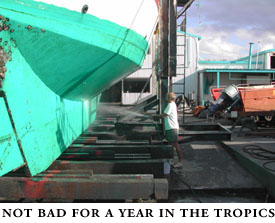
Wednesday morning we motored over to the slipway and got hauled out. This was the first time Iwalani has been hauled out on a proper railway. As she came out of the water, the yard owner remarked that he had never seen a bottom so clean. This was a good testimonial to the French Nautix bottom paint, as we had painted almost one year ago. We were in a dilemma because we couldn't get any more Nautix in Australia. Once she was out, we decided to lightly sponge off the slime and salvage as much of the paint as we could. It took all day to clean the bottom by hand, but we just couldn't risk blasting off the best paint we had ever used. The worst part about being hauled out of the water is getting in and out of the boat. Amy is afraid of heights and climbing 18 feet in the air on a ladder is not her cup of tea. 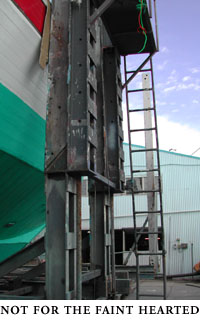
Thursday morning we walked to a nearby grass field and I tried out the rubber band powered airplane I had been building over the past few months. After a few test glides, I was able to trim it out and get in a few good flights. It was nice to get away from boat stuff, for a few minutes at least. While Amy went shopping for provisions, I put a barrier coat on the rudder and ballast. Somehow, she got it into her head that it would be easier to haul the supplies up to the deck, with a rope, than to carry them all the way out to the dock. It actually worked quite well. But it did add to the chaos of being hauled out. I was able to get a coat of Altex bottom paint on over the barrier before nightfall. |
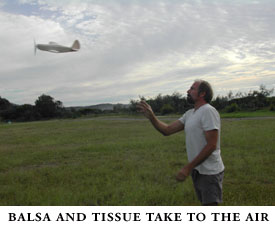
Friday, I put the second coat of Altex over the barrier coat and went around the waterline with the last of our precious Nautix. I'll be interested to see if the new Altex will outlast the one year old Nautix. We'll keep you posted. I checked all the thru hulls and replaced the shaft zinc. We were all set for a late afternoon launching. At the last minute, it occurred to Amy that this was Friday. "Phil, do you realize this is Friday?" While we don't leave port on a Friday, re-launching and heading to a marina dock seemed pretty safe. While my docking job could have been better, (Amy put a fender between Iwalani and the floating dock just in time to save our new topside paint job) I wasn't taking any chances. I'd rather hit the dock than the expensive boat in the next slip. We spent Saturday cleaning up from the haul-out. Lots of dirt made its way on deck. The wind came up quite strong. From the satellite pictures I was getting, I could see that the low that had passed to the south of us had intensified. A look at the weather chart on the Internet confirmed a squash zone had formed between the low and an approaching high. We are studying the weather patterns closely, as the conditions along the East Coast of Africa should be similar. I also noticed tropical cyclone "Errol" along the path we will be taking in the Indian Ocean. Glad we didn't try an early start. The way things are going, that won't be a problem. Between finishing the hard dodger and getting the Inmarsat-C fixed, we'll be here till after my birthday for sure. Amy is panicking, but getting worked up at the last minute is typical. No matter how much time you allow yourself for a job, things always seem to get put off till the last minute. We have been spending way too much time on this Inmarsat problem though. That's all for this week. PS Log for the week of Sunday May 19th, 2002, Coff's Harbour NSW Australia by APW We are a few pencil scratches away from finishing up "the list". The list was heavily weighted with jobs only Phil's expertise could handle. So, despite the forty-year learning curve he has over me, we began getting things done by working together. Sometimes late at night wearing miner's lamps.
Living in a marina for the last six months has been an experience for me. It is bizarre because, despite passing everyone several times a day and saying good day, or whatever, no one knows our name. They don't even know that we are American. When a friend of ours was looking for the American couple, no one had a clue that it was us they were looking for. We are usually the first to get up and the last to go to bed. It is also the time for the "snow bird" migration. Only in Australia they don't have a name for the annual migration of yachts travelling northward to warmer latitudes. Every evening, late at night, a new yacht arrives at the end of our pier and leaves early the next morning before the marina office opens- thus avoiding paying marina fees. Neither Phil, nor I have been getting much sleep. Among other electronic problems we've been having- our step down transformer had been repeatedly dying on us. The first time it happened back in January, we drove ten hours round trip to Newcastle to get it repaired, because the company that made it said there were no competent people in Coff's Harbour who could service it. The second time it happened- I got on the phone and asked if they couldn't just send up a new circuit board and I could replace it myself. "But you've got to be careful to keep the wires in alignment" they said. Reluctantly they overnighted up the forty-dollar piece. The third time it happened I was beginning to get a little frustrated and also a little suspicious as to why it was happening. Our retired electrical engineer friend, Brian, said we were putting too much of a demand on it from the 110 side. I just couldn't figure how this was happening, as it blew up when I wasn't using any power. Brian said that Coff's is notorious for power surges...
The other great-unsung hero of this trip has been the Fluke voltage tester. I can't imagine having lived this long without one. I've been running around the boat testing everything- including my tongue. What a cool thing it is. No boat or home should be without one and every girl should know how to use it.
I've been scouting around the harbor, looking for someone with a Trimble antenna. Maybe if we swapped antennas, we'd know if the antenna was the problem. I saw one on a fishing boat and after some detective work called the owner of the "Coralynn'. It was exactly the right antenna but his boys were out fishing for the a few days. He said that he had to have Inmarsat in order to fish in Queeensland. The Inmarsat there are used as tracking devices, so the government can make sure fishermen aren't in illegal waters. Needless to say, Fishermen hate these devices. He gave me the name of a fellow North of here, who not only sells Trimbles- but repairs them too. For anyone interested- his name is Brain Kelligan 02-6645-2777. I phoned him and he just happened to have a brand new antenna on the shelf. He offered to send it down to Country Wide Communications and we could hook it up and see if that was the problem. I went to pick the antenna up and met another bloke at Country Wide who was reluctant to hand me a $2500 antenna with no cash exchanged. "But I don't want to pay for if it doesn't solve the problem" I told him "Well, we don't even know what the voltage is coming out of your coax" he said, "You could damage the antenna." Now I just happened to know the voltage, having just finished fiddling with the fantastic Fluke voltmeter. "The voltage at the end of the coax is 11.22 Amps at rest and 30.22 volts on transmit." I told him. This was not what he expected to hear out of some dumb broad. "Uh. OK I send someone right down with the antenna." Unfortunately, that didn't make it work either. So, hopefully by midnight Monday we'll be up and running with the new Stratos account. If not, it's a camping trip up to Yamba with all the equipment off the boat once again. I've also got to see the deep dark insides of our SEA radio. This also has been giving us trouble since the Galapagos. People complained of a carrier, or tone, each time we transmitted. Towards the middle of the Pacific they complained that we sounded like Mickey Mouse. Great. I have a hard enough time talking on the radio without knowing I sound like a cartoon character. There are no SEA repair places in Australia, so I had the technical manual overnighted to us and a friend of Brian's agreed to help us look at the radio. He looked at the technical drawings first, then showed us what all the components are. The radio is only putting out 20 watts- instead of the usual 150. It's no wonder we were losing radio contact with everyone. Because the radio is digital, most of the transistor circuitry has been replaced with microprocessors. The technician at SEA Washington, US, walked me through the places to check for continuity. Even using Peter's oscilloscope we could only pin it down to two possible places. The four finals- lozenge shaped transmitters a chimp could solder in, to the tune of 80$- plus a two week delivery time from the US- or the "chip" that has twenty of the tiniest solders I have seen in my life. This is the kind of soldering you do wearing a white suit, using a microscope and living in a padded room- so that when you mess up the nineteenth solder you won't hurt yourself when you pound your head against the wall. So, our options are to send the radio back to the US and wait a month to get it back, or live with it as it is and get it fixed in South Africa- or spend 1400$ US on a new ICOM. This decision will have to wait for the outcome of the Inmarsat.
On Sunday we celebrated Phil's birthday. Neither of us can remember which one it was. Phil didn't want a party, only lasagna, Whoopie pies and no boat work. Well, we did sort of test out the Inmarsat while taking the time to drive to sunny Sawtell for lunch. Now for those of you not familiar with Maine and Mainer things, "Whoopie pies" are the quintessential culmination of years of American corporate food testing mixed with Grandma's research. They are chocolate cakes, filled with creamy white stuff, wrapped in plastic and sold at the checkout counter of any gas station, or Mom and Pop's store, anywhere in Maine. Here is the recipe for Iwalani's Whoopy pies- read it and drool you poor deprived people, who know not, the tantalizing richness of pure marshmallow Fluff, the ultimate dodginess of Crisco and the true chocolate essence of Hersheys powder... Thanks Whistle for getting the Fluff into the country-it really made Phil's day. APW Whoopie Pies The luscious "cakes": 6 Tablespoons butter 1 cup sugar 1 teaspoon vanilla (real vanilla is OK) 2 c. flour 5 Tablespoons Hershey's powder 1 1/4 teaspoons baking soda 1 cup milk Cream together butter and sugar. Add dry ingredients alternately with milk. Drop by spoonfuls on to cookie sheets. Bake at 350 for 12-15 minutes. The filling: three quaters cup Crisco three quaters cup powdered sugar 6 heaping tablespoons of Marshmallow Fluff Fill two cookie halves with the filling. Wrap individually in plastic wrap, for that Mom and Pop's store feeling. APW
Log for the week of May 26, 2002 Coff's Harbour by PS Our time here at the marina is drawing to a close and the boat looks like it did just before we left Maine. Stuff everywhere. Lots of half finished projects that don't warrant putting away the necessary supplies and tools. As I write this, the engine room looks like a storage closet that's been turned upside-down and shaken vigorously. The "to do" list has grown shorter. The Blister (as I now call the hard dodger) is finished. It's not pretty, but it's more substantial than the canvas dodger was. It was Ms "form before function" that wanted it put on and now Mr. "function" is wingeing about how it looks. I've never liked doghouses on boats. I hope it serves us well crossing the Indian Ocean. 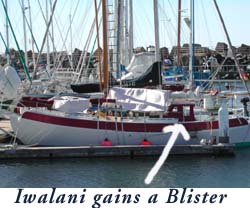
I used 9.5mm Lexan windows, bolted to the outside of the house. "Concrete Bob" (our neighbor in a Ferro-cement boat) gave me a long lecture about his experience with Lexan windows. After several attempts, with varying degrees of success, he finally got a good seal by using 1mm plastic washers under the bolts and using acid cure silicon. I used the plastic washers, but not the acid cure silicon. The glass shop said it was a bad idea. They told Bob the same thing, but the proof is in the fact that his acid cure has lasted six years. Thanks to some local fisherman contacts that Amy made, we were able to finally get a service rep to look at our Inmarsat-C. It was a two-hour drive up north to Maclean. The road follows the Clarence River valley, which had large sugar cane crops ready to harvest. Only the roofs of the farmhouses were visible above the tall cane. Brian Kelligan works out of his house and gets his business by word of mouth. He and his son Steve worked on it in a very neat and tidy room. There was a place for everything and everything was in its place. Brian was able to put his hand on whatever he was looking for. It's the kind of shop I dream about having. My shop at home gets that way once in a while when I just can't stand the clutter. It doesn't last more than a month though. We learned that they were helicopter pilots. No wonder they were so neat and organized. Helicopters have no tolerance for sloppy habits. After about an hour Steve diagnosed a bad antenna. With a new antenna he got it logged in and sending e-mail. Brian called the local Trimble rep. and was told we would have to pay for the new antenna and try to get reimbursed directly from Trimble. Not good news. The antenna was $2,400 AU. We were so glad to have it working, so we agreed to return with the cash in a few days. Finally, we could move on to other problems, namely the SEA radio. Brian kindly agreed to look at it over the next day or so. We left it with him, our fingers crossed. 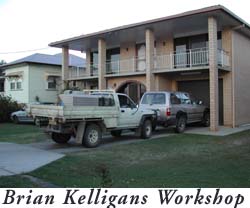
We arrived back on Iwalani and I hooked up the Inmarsat, only to have the same logging in problems. Aggg. Amy got on the phone to Brian and we talked over exactly how Steve got it to log on. Following the exact routine he had used, it worked. It's not a conventional way of logging on, but it works. The Inmarsat is now logging on and we can send and receive e-mail. There is a problem though. We changed our e-mail provider to Stratos and they notified everyone on our "accept list" with the wrong mailing address. So, now we have to straighten that out. As you may recall, the lack of good customer service is a hallmark of Stratos. I called Roger Roy in California and told him about the cash for the antenna deal. He said that he would speak to Trimble and get things straightened out. Brian called us the following day and said he had spoken to Roger and the warranty would cover the antenna but not his time. $200 AU was better than $2,400. He had the SEA radio putting out 150 watts, but he wasn't too sure about the audio. We made another trip to Maclean and paid him for his time. On the way back to Coff's we stopped at an old ferry landing. There was a ferryboat on display, along with a canal boat. The ferry was interesting because it used a cable to pull itself back and forth across the river instead of using propellers. 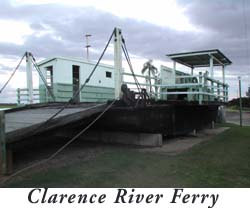
I got the radio hooked up and was blasting out the stereo speakers with my transmission, but Sydney radio couldn't understand a word I was saying. "Vessel calling Sydney radio, I can't understand your transmission. You need to have your radio fixed." was the response. I called back saying I had just gotten it back from the shop, but he couldn't understand that either. Now what to do? We could blast out unintelligible transmissions halfway around the world. What good is that? I decided to open up the tuner case to see if there were any obvious problems. Other than a little moisture coming out of the end of the antenna wire, there were no signs of trouble. I decided to change the antenna wire, just to be sure I covered as many bases as possible. I don't hold much hope for it. We may be getting the ICOM after all. In between fixing my own problems I offered to help our neighbor with his JVCom32 fax software. Seems that he couldn't get the computer clock timing correct. All his faxes had a big slant in them. Peter had been trying for a long time to fix it. After a few minutes I had things "straightened out" so to speak. Weather is on our minds, along with all our projects. Our Inmarsat broadcast a warning about a new cyclone forming directly north of us. "But it's after cyclone season." you say. If there is one thing you can't depend on, it's the weather. We are glad to still be in Coff's Harbour rather that up north looking for a shelter from nature's worst nightmare. PS |

 It was in a rather downtrodden mood that Stew and I arrived back to Iwalani, only to find Phil somewhere in the middle of a cloud of sawdust, down below, putting the last piece of trim in place. Yes, I did say the famous four letter word. He had decided that in order to boost my spirits he would install the cherry in it's rightful place, not in the lazarette underneath the crab net. It really looks quite nice and the sawdust in every nook and cranny of the boat including most recently, the butter in the ice box, is worth it.
It was in a rather downtrodden mood that Stew and I arrived back to Iwalani, only to find Phil somewhere in the middle of a cloud of sawdust, down below, putting the last piece of trim in place. Yes, I did say the famous four letter word. He had decided that in order to boost my spirits he would install the cherry in it's rightful place, not in the lazarette underneath the crab net. It really looks quite nice and the sawdust in every nook and cranny of the boat including most recently, the butter in the ice box, is worth it. 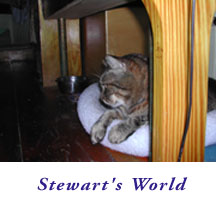 Years ago when he was so sick I thought for sure it was the end, he pulled through not just once, but several times. How many of his nine lives have been used up? I have not gone to such extremes with the rest of my pets- but they are clearly not quite the same... And in reality a four foot space on a boat is really not so bad. He has no risk of getting hit by a car, falling overboard, eaten by a large animal- plus he has two humans attending to his every need twenty- four hours a day. What is a fair life for any one of us?
Years ago when he was so sick I thought for sure it was the end, he pulled through not just once, but several times. How many of his nine lives have been used up? I have not gone to such extremes with the rest of my pets- but they are clearly not quite the same... And in reality a four foot space on a boat is really not so bad. He has no risk of getting hit by a car, falling overboard, eaten by a large animal- plus he has two humans attending to his every need twenty- four hours a day. What is a fair life for any one of us?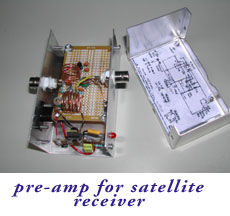 Brian, the local ham/satellite radio guru made us a pre-amp to boost the signal we get in from the quad-helix antenna, for receiving satellite weather imagery. I look at it with complete amazement and can't imagine the time and skill involved in making something like this. From a sketch he made of squiggles, lines and curley cews- he built tiny little soldered circuit boards, doll sized little hand spun copper coils, little colored beads and other mysterious electronic components, all according to the plan- very beautiful and yet very functional too. Wearing such a creation around ones' neck makes far more sense to me than wearing a bunch of rocks. It really is beautiful. It works well- although in the marina it is boosting the local interference as well as the satellite signal.
Brian, the local ham/satellite radio guru made us a pre-amp to boost the signal we get in from the quad-helix antenna, for receiving satellite weather imagery. I look at it with complete amazement and can't imagine the time and skill involved in making something like this. From a sketch he made of squiggles, lines and curley cews- he built tiny little soldered circuit boards, doll sized little hand spun copper coils, little colored beads and other mysterious electronic components, all according to the plan- very beautiful and yet very functional too. Wearing such a creation around ones' neck makes far more sense to me than wearing a bunch of rocks. It really is beautiful. It works well- although in the marina it is boosting the local interference as well as the satellite signal.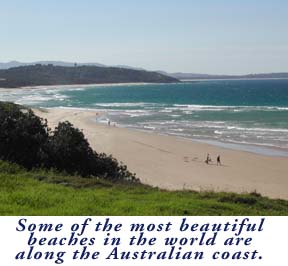 Winter has arrived in Coff's Harbour. The Aussies all wear jackets, sweaters and on some poor chilled skulls- wool caps. The temperatures have nose dived to about 53 degrees at night, yet remain a balmy 68 during the day. Phil still is wearing his bathing suit.
Winter has arrived in Coff's Harbour. The Aussies all wear jackets, sweaters and on some poor chilled skulls- wool caps. The temperatures have nose dived to about 53 degrees at night, yet remain a balmy 68 during the day. Phil still is wearing his bathing suit.  With infinite patience and quite a bit of hair pulling on both his and Phil's parts, they did teach me how to solder in the little ceramic ballast resistors. So I went to the local Dick Smith's electronic store and stocked up on plenty of these twenty five-cent parts. We even put in a replaceable fuse on the 240 side. Each time the transformer died I became the repair guy while Phil did the dishes or made supper. It seemed like I was replacing the resistor every three days or so. Finally, one evening, another yacht came in and tied up at the end of the pier. Our power went out. I went out with a flash light and found that they had unplugged us and re-plugged us in with their own power cord and a splitter. Finally, I figured out why our transformer was dying- by interrupting the power for even a second, the ice box and light on board were still drawing electricity and putting a load on the system. This was enough to blow up the resistor in the circuit board. So, the lesson I have learned while living in a marina, is to never un-plug a boats power cord, without at least knocking on the hull and asking if its ok. We wondered why all the other live aboards had duct taped the living bejeezus out of their outlets. Until I get another fuse on the 110 side, our power cord now has even more duct tape than our neighbors. That'll teach people who think they can come in late at night, hook up and then buzz out without paying.
With infinite patience and quite a bit of hair pulling on both his and Phil's parts, they did teach me how to solder in the little ceramic ballast resistors. So I went to the local Dick Smith's electronic store and stocked up on plenty of these twenty five-cent parts. We even put in a replaceable fuse on the 240 side. Each time the transformer died I became the repair guy while Phil did the dishes or made supper. It seemed like I was replacing the resistor every three days or so. Finally, one evening, another yacht came in and tied up at the end of the pier. Our power went out. I went out with a flash light and found that they had unplugged us and re-plugged us in with their own power cord and a splitter. Finally, I figured out why our transformer was dying- by interrupting the power for even a second, the ice box and light on board were still drawing electricity and putting a load on the system. This was enough to blow up the resistor in the circuit board. So, the lesson I have learned while living in a marina, is to never un-plug a boats power cord, without at least knocking on the hull and asking if its ok. We wondered why all the other live aboards had duct taped the living bejeezus out of their outlets. Until I get another fuse on the 110 side, our power cord now has even more duct tape than our neighbors. That'll teach people who think they can come in late at night, hook up and then buzz out without paying.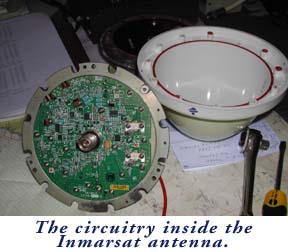 Unfortunately, despite the Fluke we are still no closer to solving the mysterious Inmarsat problem. For those of you not knowing what Inmarsat is I will sum up in a nutshell. On board we have a laptop computer, which is connected by cable to a black box made by Trimble. This black box acts almost like a modem and sends our email out to a little an eggshaped antenna, (also made by Trimble) on the stern railing, the egg beams up our email to one of four fixed equatorial satellites, which beams the info back to a land earth station-or LES that passes the email on to people's computers. Kind of like using AOL, or Earthlink, for your home service provider. Inmarsat owns the four satellites, any number of companies can make the black boxes, (besides Trimble)and worst of all, there are many LES's. We had been very happy using Comsat, until I found out from the London Inmarsat people that we had no accounting authority selected. When we signed up with Comsat, we told them to do whatever it took to get us around the world. For some reason they set up our account with ISP billing. Which, from what I can figure out means that they must have reciprocal agreement with the LES and satellite. An accounting authority means that someone, somewhere, is going to pay the bill. In our case our Visa card. Comsat swears up and down that this isn't a problem for the Pacific Ocean region. They said there might have been a problem in the Indian Ocean- but not to worry. If they didn't have reciprocal agreement, our Inmarsat would be virtually useless. Glad we found this out now, while we had the best and cheapest phone system in the world, hooked to our boat. So, what we have now done is to cancel our account with Comsat, and have opened an account with Stratos, their main competitor, with Stratos as the accounting authority. I have to admit the customer service from Comsat has been great. After all the phone calls I have made, I feel like I know them all. Stratos has never had the best customer service. Which is why we didn't go with them in the first place. "We are service providers for the US Navy, why would you want to go with Comsat?" has been there hoity attitude- even now. I've always been a sucker for the little guy. So, when I called Newfoundland, to get our Stratos account activated and gave the woman the necessary information to complete the application, I asked her if she would be getting it up and running that night. "I have no idea" she said, "I get off at 11:30 and then we are closed for the weekend". Great. I hope we haven't jumped out of the frying pan and into the fire. Since I had to deactivate the account with Comsat in order to activate it with Stratos, we are dead in the water so to speak, until Monday at midnight, Aussie time. With no service provider, we can not log in at all- we do still get a GPS position, but no weather bulletins(EGC's).
Unfortunately, despite the Fluke we are still no closer to solving the mysterious Inmarsat problem. For those of you not knowing what Inmarsat is I will sum up in a nutshell. On board we have a laptop computer, which is connected by cable to a black box made by Trimble. This black box acts almost like a modem and sends our email out to a little an eggshaped antenna, (also made by Trimble) on the stern railing, the egg beams up our email to one of four fixed equatorial satellites, which beams the info back to a land earth station-or LES that passes the email on to people's computers. Kind of like using AOL, or Earthlink, for your home service provider. Inmarsat owns the four satellites, any number of companies can make the black boxes, (besides Trimble)and worst of all, there are many LES's. We had been very happy using Comsat, until I found out from the London Inmarsat people that we had no accounting authority selected. When we signed up with Comsat, we told them to do whatever it took to get us around the world. For some reason they set up our account with ISP billing. Which, from what I can figure out means that they must have reciprocal agreement with the LES and satellite. An accounting authority means that someone, somewhere, is going to pay the bill. In our case our Visa card. Comsat swears up and down that this isn't a problem for the Pacific Ocean region. They said there might have been a problem in the Indian Ocean- but not to worry. If they didn't have reciprocal agreement, our Inmarsat would be virtually useless. Glad we found this out now, while we had the best and cheapest phone system in the world, hooked to our boat. So, what we have now done is to cancel our account with Comsat, and have opened an account with Stratos, their main competitor, with Stratos as the accounting authority. I have to admit the customer service from Comsat has been great. After all the phone calls I have made, I feel like I know them all. Stratos has never had the best customer service. Which is why we didn't go with them in the first place. "We are service providers for the US Navy, why would you want to go with Comsat?" has been there hoity attitude- even now. I've always been a sucker for the little guy. So, when I called Newfoundland, to get our Stratos account activated and gave the woman the necessary information to complete the application, I asked her if she would be getting it up and running that night. "I have no idea" she said, "I get off at 11:30 and then we are closed for the weekend". Great. I hope we haven't jumped out of the frying pan and into the fire. Since I had to deactivate the account with Comsat in order to activate it with Stratos, we are dead in the water so to speak, until Monday at midnight, Aussie time. With no service provider, we can not log in at all- we do still get a GPS position, but no weather bulletins(EGC's).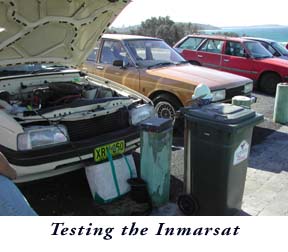 And how is the repair going on the ship's cat? I phoned- got to love this cheap Telstra service, a Veterinary neurologist to consult over what to do with Stew. He's no worse, but no better. The neurologist told me to calm down about the tumor- she thought my original diagnosis of chronic toxoplasmosis, far more likely given Stew's signs. So I am continuing the whopping dose of Clindamycin, which I hate to say I am pretty bad at remembering to give. It's very bitter and neither of us likes the ordeal of cramming it in his mouth. I'm a much better doctor than nurse, or patient. The three of us have been learning to adjust to his new limitations.
And how is the repair going on the ship's cat? I phoned- got to love this cheap Telstra service, a Veterinary neurologist to consult over what to do with Stew. He's no worse, but no better. The neurologist told me to calm down about the tumor- she thought my original diagnosis of chronic toxoplasmosis, far more likely given Stew's signs. So I am continuing the whopping dose of Clindamycin, which I hate to say I am pretty bad at remembering to give. It's very bitter and neither of us likes the ordeal of cramming it in his mouth. I'm a much better doctor than nurse, or patient. The three of us have been learning to adjust to his new limitations.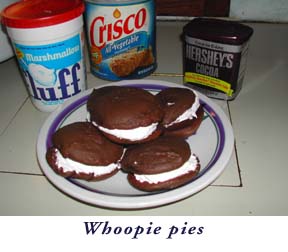 They are usually baked in the kitchen of sweet, little old gray haired ladies, wearing checked apron's, only wishing for a little spare pocket change to buy the grandkid's birthday presents. The "pies" are often of indeterminate age- which is unimportant, as there is not a single molecule of anything remotely prone to decay or rancidity in their calorie laden, cream filled loveliness. In fact, no one in Australia can even remotely conceive of their creation, as the key ingredients have never been heard of, on these beetroot, carrot grated, health food filled shores.
They are usually baked in the kitchen of sweet, little old gray haired ladies, wearing checked apron's, only wishing for a little spare pocket change to buy the grandkid's birthday presents. The "pies" are often of indeterminate age- which is unimportant, as there is not a single molecule of anything remotely prone to decay or rancidity in their calorie laden, cream filled loveliness. In fact, no one in Australia can even remotely conceive of their creation, as the key ingredients have never been heard of, on these beetroot, carrot grated, health food filled shores.